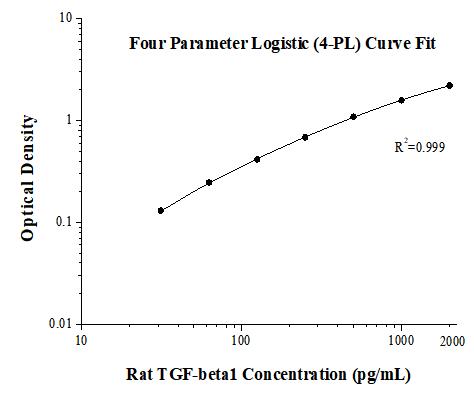Rat TGF-beta1 ELISA Kit
Validation Data Gallery
Product Information
KE20010 is a solid phase sandwich Enzyme Linked-Immuno-Sorbent Assay (Sandwich ELISA). The TGF-beta1 ELISA kit is to be used to detect and quantify protein levels of endogenous TGF-beta1. The assay recognizes Rat TGF-beta1. An antibody specific for TGF-beta1 has been pre-coated onto the microwells. The TGF-beta1 protein in samples is captured by the coated antibody after incubation. Following extensive washing, another antibody of biotinylated specific for TGF-beta1 is added to detect the captured TGF-beta1 protein. For signal development, Streptavidin-HRP is added, followed by Tetramethyl-benzidine (TMB) reagent. Solution containing sulfuric acid is used to stop color development and the color intensity which is proportional to the quantity of bound protein is measurable at 450 nm with the correction wavelength set at 630 nm. This ELISA kit is cross-reactive with bovine, porcine, equine, and caprine. Therefore, the culture medium should not contain serum components associated with the above species.
| Product name | Rat TGF-beta1 ELISA Kit |
| Tests | 1 X 96 well plate |
| Sample type | Serum, Plasma, Cell culture supernatants |
| Assay type | Sandwich |
| Sensitivity | 3.4 pg/mL |
| Range | 31.25 - 2000 pg/mL |
| Reactivity | Rat |
| Tested applications | Sandwich ELISA |
| Gene ID (NCBI) | 59086 |
Recovery
| Sample Type | Average | Range |
|---|---|---|
| cell culture supernatants | 100 | 78-126 |
| rat serum | 99 | 81-114 |
IntraAssay
| Sample | n | mean ( pg/mL) | SD | CV% |
|---|---|---|---|---|
| 1 | 20 | 43.6 | 3.3 | 7.5 |
| 2 | 20 | 245.3 | 11.1 | 4.5 |
| 3 | 20 | 1027.5 | 53.2 | 5.2 |
InterAssay
| Sample | n | mean ( pg/mL) | SD | CV% |
|---|---|---|---|---|
| 1 | 24 | 55.5 | 4.5 | 8.1 |
| 2 | 24 | 251.8 | 23.0 | 9.1 |
| 3 | 24 | 1079.7 | 94.4 | 8.7 |
Background Information
TGF-beta is a member of the transforming growth factor beta (TGFB) family of cytokines, which are multifunctional peptides that regulate proliferation, differentiation, adhesion, migration, and other functions in many cell types. TGF-beta is produced by a number of cell types including regulatory T cells, fibroblasts, epithelial cells, and endothelial cells. TGF-beta acts synergistically with TGFA in inducing transformation. It also acts as a negative autocrine growth factor. TGF-beta plays an important role in bone remodeling as it is a potent stimulator of osteoblastic bone formation, causing chemotaxis, proliferation and differentiation in committed osteoblasts. TGF-beta appears to promote late stage progression and metastasis in some cancers.
Properties
| Storage Instructions | All the reagents are stored at 2-8℃ for 6 months or -20℃ for 12 months. Refer to the protocol for further storage instructions. |
| Synonyms | Tgfb1, TGF-beta1, TGFβ1, TGF-β1 |
Publications
| Species | Sample Type | Title |
|---|---|---|
Proc Natl Acad Sci U S A An endoscopically compatible fast-gelation powder forms Janus-adhesive hydrogel barrier to prevent postoperative adhesions | ||
NPJ Regen Med Alkaline shear-thinning micro-nanocomposite hydrogels initiate endogenous TGFβ signaling for in situ bone regeneration | ||
CNS Neurosci Ther miR-26a-5p alleviates CFA-induced chronic inflammatory hyperalgesia through Wnt5a/CaMKII/NFAT signaling in mice | ||
Stem Cell Res Ther Exendin-4 and eldecalcitol synergistically promote osteogenic differentiation of bone marrow mesenchymal stem cells through M2 macrophages polarization via PI3K/AKT pathway. | ||
Cell Immunol Muscone promotes functional recovery by facilitating microglia polarization into M2 phenotype through PPAR-γ pathway after ischemic stroke | ||
J Agric Food Chem Protective Effect of Tangeretin and 5-Hydroxy-6,7,8,3',4'-Pentamethoxyflavone on Collagen-Induced Arthritis by Inhibiting Autophagy via Activation of the ROS-AKT/mTOR Signaling Pathway. |


